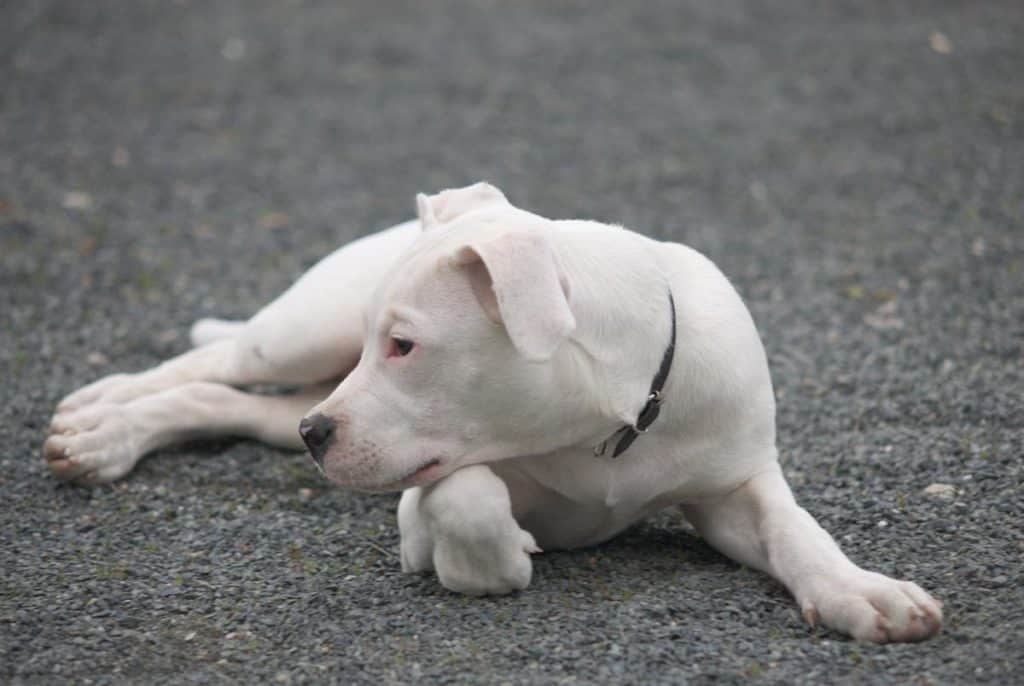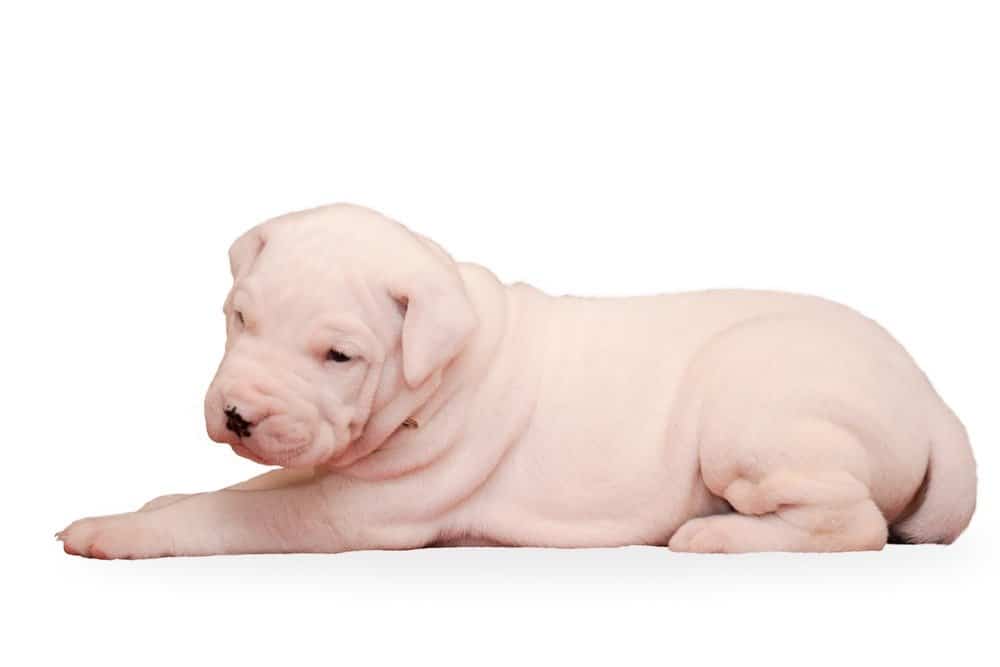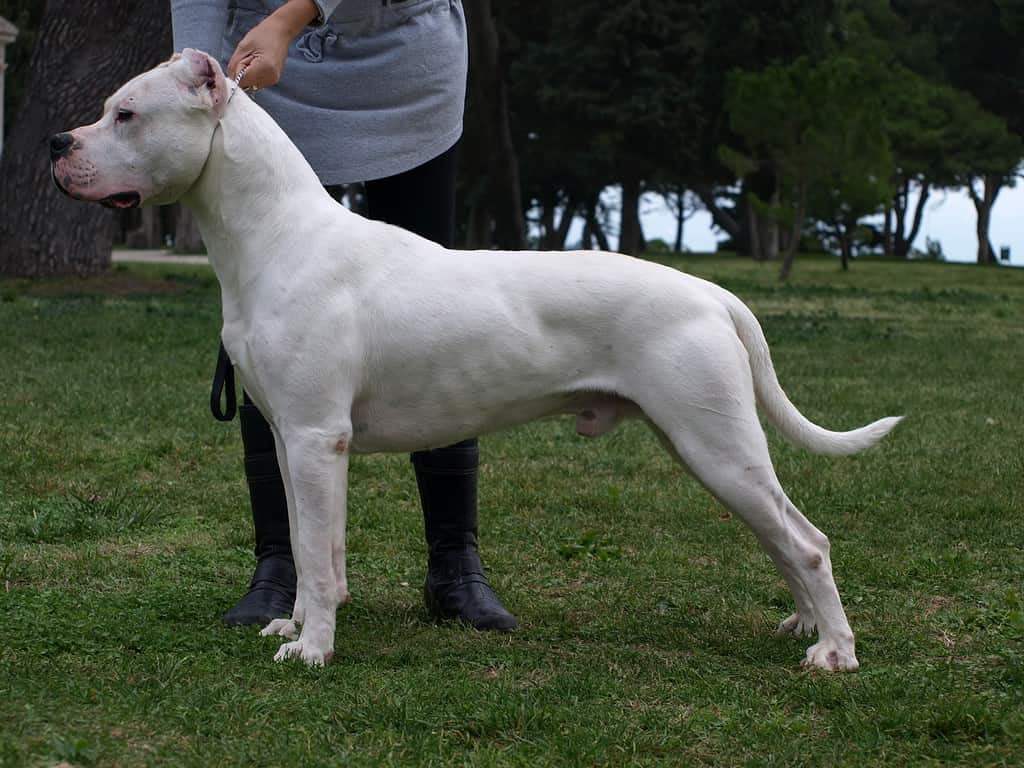Dogo Argentino Summary
As the breed’s name suggests, this canine was originally bred in Argentina, where it was used to hunt large game. They’re known for being very protective and loyal, which can potentially make them good family dogs. However, they do require a lot of socialization and training, and they can reach nearly 100 pounds. Therefore, we typically only recommend them for experienced dog owners.
Dogo Argentino Growth and Weight Chart by Age
| Age | Male Weight | Female Weight |
|---|---|---|
| 2 | 25-35 | 20-30 |
| 3 | 35-50 | 30-45 |
| 4 | 50-65 | 45-60 |
| 5 | 60-75 | 55-70 |
| 6 | 75-95 | 60-80 |
| 7 | 80-100 | 65-85 |
| 8 | 85-110 | 70-90 |
| 9 | 90-115 | 75-95 |
| 12 | 90-110 | 75-95 |
| 18 | 95-115 | 80-95 |
This chart provides a rough outline of how your dogo Argentino may grow. However, each dog is an individual, and some may fall outside of this range. Females are typically smaller than males, but this isn’t always the case.
When Will My Dogo Argentino Stop Growing?

It may not look like it, but this puppy could reach 100 pounds by the time he is two years old.
©Janne / Flickr – Original
Typically, these canines grow for quite a while, as they are very large. It takes them a while to grow from a small puppy to a nearly 100-pound dog. Generally, they will reach their full height at around 12 to 18 months. Females typically get done growing sooner, as they are smaller (and, therefore, need to grow less).
However, these dogs also have a lot of muscle as adults, and it may take them several more months to “fill out” after reaching their full height. Larger males may not reach their full size until closer to two years.
You can bet that these dogs will generally all be done growing by the time they turn two, though some smaller ones may be done by the time they’re 18 months old. Because these dogs are so large, there is a lot of variance on when a particular dog may stop growing.
How Big Will My Dogo Argentino Be When It’s Fully Grown?
These dogs weigh between 80 to 100 pounds when fully grown, according to the AKC. While the kennel club does not divide the standard based on gender, males are usually larger than females. Of course, this isn’t true in all cases.
Either way, these dogs are exceptionally large and can be pretty imposing.
When Should My Dogo Argentino Be Spayed or Neutered?
Typically, when you should spay or neuter your dog depends on who you ask. Many vets and national organizations recommend spaying or neutering your dog earlier rather than later, usually around six months old. Doing the surgery early helps prevent accidental pregnancies and can lower your dog’s risk of certain health problems.
According to the American Veterinary Medical Association, spaying and neutering your dog helps prevent the risk of certain cancers. It can also help prevent common behavioral problems associated with the hormonal changes that occur during your dog’s puberty.
However, others recommend waiting until the dog is fully grown before spaying or neutering them. Dogs need their reproductive hormones during the latter part of their growth, which occurs during puberty. If they aren’t producing these hormones because they’ve already been spayed or neutered, then they may not grow correctly.
Larger dogs seem to have a higher risk of joint and bone problems if spayed or neutered early. Of course, the dogo Argentino would fall into this category.
Therefore, you’ll need to work closely with your vet to determine when the best time to spay or neuter your dog is.
When Should My Dogo Argentino Be House Broken?
Housebreaking your Dogo Argentino requires patience and consistency. However, these dogs are usually pretty easy to house train, as they are larger. Their bigger size also applies to their bladder, so they need to go outside less often than smaller breeds. In the end, this makes it much easier to house break them.
However, that doesn’t mean that they’ll just potty train themselves. Instead, you’ll need to create a routine that involves taking them out on a regular basis. Preferably, you should take them out thirty minutes after each meal, after waking up, and before bedtime – as well as at other times throughout the day.
The more you take your puppy out, the more opportunities they have for success. Therefore, you should aim to take them outside more than they may need.
Choose a particular spot to take your dog each time they use the bathroom. Eventually, your dog will understand the difference between “inside” and “outside.” However, for now, it’s often easier to teach them to go to one particular spot.
Whenever your dog is successful, be sure to reward and praise them. Positive reinforcement can go a long way to ensuring that your canine catches on quickly.
When your dog is inside, close supervision is required. You want to stay on the lookout for any sign that your pet needs to use the bathroom – just in case they need to go off schedule. If you notice any sniffing or circling, take your dog outside right away.
When you can’t supervise your dogo Argentino puppy, consider crate training. Dogs generally won’t eliminate in their crate where they sleep, making it a valuable tool for potty training.
Of course, most dogs will have accidents eventually. In these cases, clean up the accident properly with an enzymatic cleaner. These cleaners help remove the smell, which will prevent your dog from going in that spot again.
When Should My Dogo Argentino Stop Eating Puppy Food?
Because they take so long to reach their full size, these canines will be eating puppy food for a while. You can usually start transitioning your average dogo Argentino around 18 months. Smaller females may be able to transition closer to a year.
It’s important to remember that this is a transition. You don’t want to suddenly switch foods overnight. Instead, you should slowly add the new, adult food to your dog’s puppy food. Slowly decrease the puppy food and increase the adult food until your dog is only eating adult food.
Switching food too early can cause growth problems, especially in larger dogs like this breed. Poor nutrition is linked to canine hip dysplasia, so keeping your dog on the appropriate food until they are done developing their hips is vital.
However, keeping them on their puppy food for the rest of their lives isn’t a suitable option. Puppy food contains extra calories that adult dogs don’t need, which may cause them to gain weight. Obesity is also linked to hip dysplasia.
Therefore, it’s important to switch exactly when your dog needs to. You can work with your vet on this process, as they should be able to determine when your dog’s growth is slowing.
We highly recommend the Wellness Large Breed Complete Health Dry Dog Food. It’s full of omega fatty acids, antioxidants, glucosamine, probiotics, and taurine. It has everything in it that very large dogs need as adults.
- The kibble is crunchy for dental health
- No meat by-products, fillers, or artificial preservatives
- Contains glucosamine for joint and bone health
- Added probiotics for gut health
- High in chicken
- Grain-inclusive
When Will My Dogo Argentino Start Losing Teeth?
Dogo Argentinos may take longer to reach their full size, but they start losing their puppy teeth at around 3 to 4 months – just like every other dog breed. Around this time, you may notice your dog chewing more, as this is one way they instinctually alleviate the pain of teething.
You should provide your dog with quality chew toys and encourage them to use them. In most situations, this will help reduce the amount of inappropriate chewing they do. However, some dogs may need more guidance than others.
Plan on replacing your dog’s chew toys regularly. Because these dogs are larger, they typically need larger chew toys (which are also more expensive). Be sure to budget properly.
Your dog should be done teething by around six months old. Some dogs lose all their teeth very quickly and may be done before that, or your dog may start early and then finish late. Some amount of variance is completely normal.
When Should I Start Training My Dogo Argentino?
You should start training your dog as soon as they come into your home. Usually, these canines are sent to their forever home around 10 to 12 weeks. They’re plenty old enough to start training at this point. Quality breeders may even start before then, but you’ll need to continue training once your puppy comes home.
Training consists of three equally important parts for younger dogs: socialization, habits, and obedience training.
Because these dogs are protective, socialization is particularly important. We highly recommend getting these dogs around tons of different people, places, and things as early as possible. This process helps prevent your dog from being fearful or overprotective as an adult.
Your dog is also learning habits as soon as they walk into your home. Be sure you’re teaching good habits. For instance, dogs should never be allowed to jump up onto anyone, even as a tiny puppy.
Obedience training is what most people consider as “training,” but it is only a small portion of teaching your dog. Of course, obedience is still important and should be started as soon as your dog comes into your home, too.
We highly recommend group puppy classes, as these provide socialization and basic training.
What Cues Should I Teach My Dogo Argentino First?
There are a few basic commands that every dog should know. Most of the time, these cues build on top of each other. Therefore, it’s important to start at the beginning and slowly move onward.
That said, some cues can be taught at the same time (such as stay and come). Your dog doesn’t typically have to master a command before you introduce the next one, but some amount of familiarity is important.
We recommend teaching your dog commands in this order:
- Watch: This command teaches your dog to look at you and make eye contact (preferably). While it’s commonly overlooked, this command can help your dog focus in stressful, real-life situations when they’re likely to mess up a command.
- Sit: Once your dog is looking at you consistently, you can move on to this basic command. It’s a practical way to control your dog, and it is necessary for many other commands.
- Stay: You should start teaching your dog to “stay” as soon as they “sit” with some consistency. This is because your dog needs to sit while staying.
- Come: Teach come alongside stay. Preferably, you’ll put your dog in a stay position, walk away, and then tell them to come. Slowly build on the distance and time between the stay and come cues. If your dog can master come, they can be provided more freedom, as you can trust that they’ll come back if something dangerous happens.
- Release: We also recommend teaching an “okay” or “free,” which simply tells your dog they can move freely. Usually, this command is done after a “stay” command, but when you don’t necessarily need your dog to come.
- Wait: Wait is extremely useful. You can use it to keep your dog from running out of a door or jumping out of the car. It isn’t a “stay” command, and your dog doesn’t have to be in a sitting position. It’s just a way to keep your dog from running off.
- Leave it: This command can be used to prevent your canine from eating things they shouldn’t, bothering other people, and chasing things. It’s a catch-all phrase for “leave that alone.” It’s one of the more practical commands, but it can take a while for your dog to master it.
When Will My Dogo Argentino Calm Down?
These dogs do tend to mellow a bit as they mature. However, these dogs are exceptionally active and have a high energy level. Therefore, they work best for families that are also active. They will never reach a point where they want to lay around all day.
However, they will eventually lose the puppy exuberance they had when they were little. It takes them a bit longer to do this than other breeds, as they take longer to mature. Most will still act like puppies until they are around 18 months to 2 years old. Females tend to calm down a bit faster than males.
Training and socialization can help your dog learn to act properly in different situations. While these don’t directly translate to a lower energy level, they can help your dog expend their energy properly.
It’s also important to physically exercise your dogo Argentino. We highly recommend spending at least an hour exercising these dogs. However, due to their tendency to get joint issues, never force them to exercise. You want them to get decently tired and stop – not wear down their joints.
You should also provide some mental stimulation, which is also important. These dogs aren’t the most intelligent, but they still have brains that need to work.
Common Health Issues Your Dogo Argentino Might Experience
These dogs are a decently healthy breed. However, their larger size puts them at risk for several health problems. It also lowers their life expectancy, which is around 9 to 12 years for this breed.
The biggest issue these dogs experience is hip dysplasia, which is common amongst many larger breeds. This condition causes arthritis-like symptoms but at a much earlier age (around two years for most affected dogs). It’s partially genetic, but diet, weight, and exercise also play a role.
Older dogos may develop laryngeal paralysis, which causes the vocal cords to paralyze and hang down into the airway. Usually, this condition causes noisy breathing and not much else. Severe cases may lead to difficulty breathing, though. Luckily, it’s often treatable with medication.
Heritable deafness is also somewhat common in this breed. Careful breeding can help prevent this, but it may also seem to pop up out of seemingly nowhere.
Dogo Argentinos may also develop hypothyroidism, which occurs when the body doesn’t have enough thyroid hormones. Treatment for this is relatively simple and involves providing replacement hormones in pill form.
Pictures of Dogo Argentino as Puppies

Despite their large size, these dogs start out exceptionally small. They quickly grow, though, often surpassing smaller breeds in only a few weeks.
©GeptaYs/Shutterstock.com
Pictures of Dogo Argentino at 6 Months

Dogos grow relatively fast, so they begin looking like adult dogs rather quickly. However, it often takes them awhile to build the muscle of an adult.
©NSC Photography/Shutterstock.com
Pictures of Fully Grown Dogo Argentino

These dogs are very large and come almost exclusively in white.
The photo featured at the top of this post is © Ershov_Andrey/Shutterstock.com
Thank you for reading! Have some feedback for us? Contact the AZ Animals editorial team.








